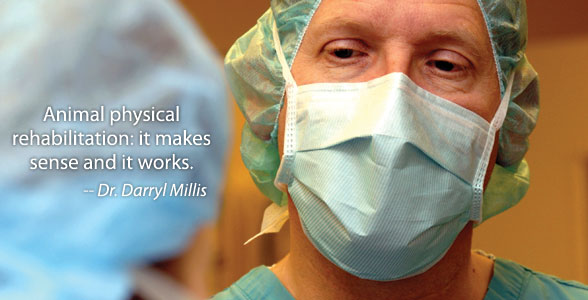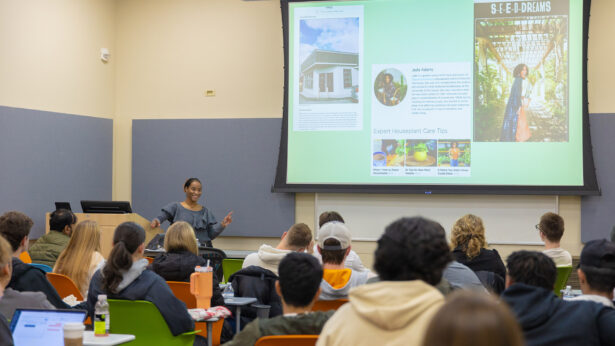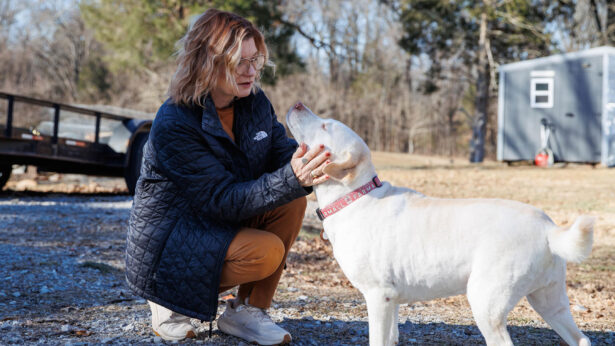Maggie Carlin could barely walk 15 feet without taking a break. Although she was only 10 years old, the vivacious redhead suffered excruciating pain from arthritis in both knees. Pain wasn’t anything new to her. At the tender age of 6 months, a veterinarian in Texas diagnosed the golden retriever with luxating kneecaps, and she underwent surgery on her knees. One was successful; the other wasn’t. “Her entire life, she had problems climbing stairs,” says Marilyn Carlin, Maggie’s owner. “A little while after we moved to Knoxville, our vet told me about the new underwater treadmill at UT.” At the time, the University of Tennessee College of Veterinary Medicine (UTCVM) was the only veterinary college in the country with an underwater treadmill.
“This was a dog that came to us with the two worst knees I’ve ever seen in terms of the amount of arthritis. Horrendous knees,” says Dr. Darryl Millis, section chief of small-animal surgery at UTCVM. Since nonsteroidal anti-inflammatory drugs upset her stomach and the Carlins didn’t want to put Maggie through any more surgeries, options were limited.
“We decided to try physical rehabilitation,” Millis says. “Maggie was coming in three times a week for aquatic therapy in the underwater treadmill. At the end of five months, force plate measurements confirmed she was weight-bearing normally at a trot on both rear limbs. Maggie remains the poster child for aquatic therapy in arthritic cases. I’d been a believer all along, but she really reinforced that.”
Throughout the rest of her life, the Carlins brought Maggie and her sister Evie (who suffered hip dysplasia) to UT twice a week for their aquatic jaunts. “Maggie was like a different dog. Her debilitated and atrophied leg developed muscle mass. The physical rehabilitation gave her almost three years of great quality life,” says Marilyn Carlin.
Maggie, who died in early 2004, was one of the first dogs to benefit from UTCVM’s underwater treadmill, and since then, the physical rehabilitation program has continued to grow. UT, in partnership with Northeast Seminars, is home to the only university-based certificate program in canine physical rehabilitation. More than a thousand veterinarians, veterinary technicians, and human physical therapists from around the world participated in the rigorous 1-year program, and nearly 200 have successfully completed the certification exam. In 2006 part of the program was taught in Europe for the first time.
Millis, the coeditor of two animal–rehabilitation textbooks, has always had an interest in lameness and bones. During his surgical residency at Michigan State University, he began contemplating the benefits of physical rehabilitation. Cage rest used to be the most prescribed post-operative recommendation for dogs, but it left much to be desired because of the muscle atrophy and joint stiffness that resulted.
“When I later taught at Mississippi State, dachshunds there were always put in the pool to swim following back surgery.” Millis says. “I noticed my dachshund patients recovered a lot quicker than what I was used to, so I put two and two together and started to figure out how we could incorporate rehabilitation to get other animals moving quicker and back on their feet.”
Human physical therapy or canine physical rehabilitation–which came first? Millis says it’s a little bit of both. “Most of the initial studies done for the benefit of human rehab were actually done on small animals, including dogs, and that information was applied to people. Unfortunately that literature was never really read much by veterinarians because it dealt with humans. Now we’re turning that around and using what we know works in humans and adapting it for dogs. It’s a nice cycle of events.”
In addition to underwater treadmills, other pieces of equipment and techniques normally found in a physical therapist’s office can be adapted for dogs, including therapy bands, ultrasound, and ice packs. Since it’s hard to explain the benefits of rehab to a dog who has had a total hip replacement, veterinarians sometimes turn the treatment into a game or offer treats to elicit certain behaviors.
Just as human doctors have embraced rehabilitation as one of the tools in their medical bag, so have veterinarians. “Usually veterinarians are very conservative, and there’s always a bit of skepticism when a new field develops. I fully expected that, especially from my colleagues who are hard-core science- and evidence-based,” Millis says.
But he says they have embraced it because it makes sense and it works. In human medicine, evidence is proving that lower-impact exercise can be as good as or better than nonsteroidal anti-inflammatory drugs for treating arthritis, for example.
“I think people see what’s happening to friends and family members, maybe even themselves, after surgery,” Millis says. “I hear a lot of comments like ‘I wouldn’t have near the function I have if it weren’t for my physical therapist.’ I think the parallels have caused physical rehabilitation to grow as rapidly as it has, and the public actually sees it as an interesting concept because they can become involved with their pet’s care and see the results.”
The canine rehabilitation program at UTCVM is limited by space. Millis says with the expansion of the vet school, which recently got underway, the program will grow to better serve the working-dog population and will become a regional center for both surgical treatment and post-operative care. Dr. Marti Drum has been hired to oversee the rehabilitation program.
“The bottom line,” Millis says, “is people expect the same level of healthcare for their animals as they receive themselves.”
Weight Loss May Be Best Medicine
When a client tells Dr. Darryl Millis his aging dog seems to be “slowing down,” Millis says that’s a verbal clue that the dog may be suffering from the chronic pain of arthritis and that the dog is probably overweight.
Although between 30 percent and 50 percent of all dogs and cats are overweight to obese, regardless of age, dogs should not be allowed to become overweight. Studies have shown that dogs kept at their optimal weight suffer fewer health problems–including arthritis–and they live longer.
When viewed from above, dogs should have an hourglass shape to their figure and the ribs should be easily felt.
“When it comes to treatment of some conditions, weight loss alone can provide as much or more value than some of the expensive drug treatments available,” Millis says.



